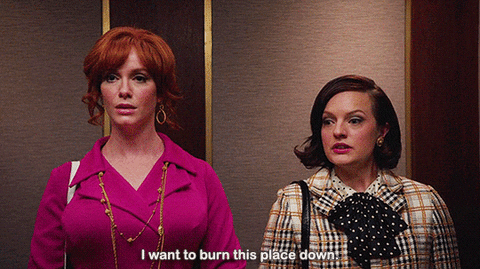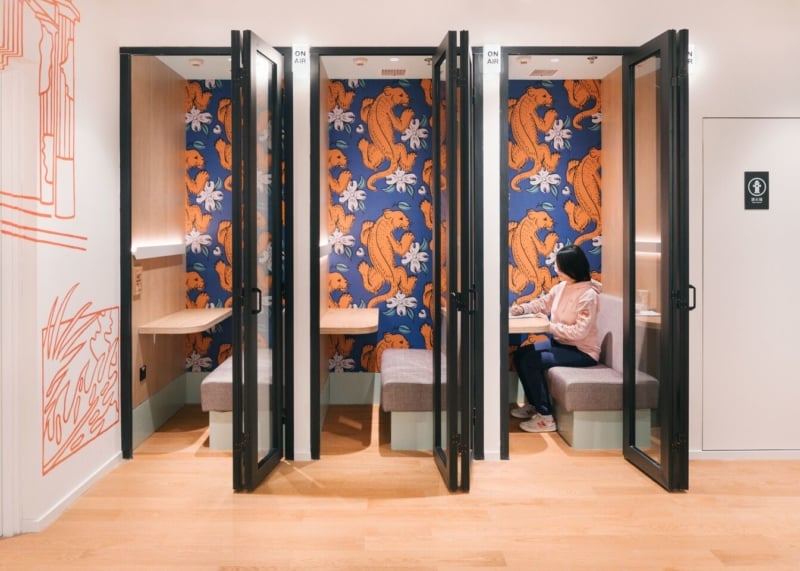Bring up open office layouts in casual conversation and you’ll likely ignite more opinions than if you’d mentioned politics at Thanksgiving dinner. Much like “office perks,” this architectural style rocketed to popularity in the mid-2010s only to fall just as swiftly. Around 2019 it seemed everyone called for its end. So why the about-face? Are open spaces actually better or worse than traditional setups? And how has Covid affected views?
There are open office space pros and cons, and we’ll argue in its favor—with some pretty important caveats.
The Rise and Fall of Open Office Spaces
It was a short honeymoon for open office design. Almost as soon as WeWork and a hundred offshoots took off, people railed against the trend. Between studies and personal anecdotes shared to publications, it seemed the experiment had failed. Open layouts were hailed as collaboration fuel, but instead most people seemed to find the cubicle alternative failed in that promise, and it seemed to enhance other less enjoyable aspects of office life.
It turned out that dumping an entire office into one big room didn’t actually increase productivity or face-to-face conversations, but messaging increased. Similar arguments were made against Slack in recent years—a productivity tool that ended up wasting more time instead of saving it. It all comes down to how you and your team use these tools, your office culture, and your personal work style and preferences. It turns out most Zoom meetings can be handled over email just like in-person meetings often can—who’d have guessed?
It’s no surprise given the studies and personal anecdotes shared that women in particular felt uncomfortable in wide-open space. The trend’s peak, right before all of the articles on its failures and studies, coincided with the rise of the Me Too movement, especially in tech offices.

The Caveat: Why the Ire Got (Some of) It Wrong
There is a pretty big asterisk missing from many of these open space studies. They mostly focus on the extreme end of “open.” As in, take your typical giant room of cubicles and just… remove the cubicles. That sounds like a pretty lousy work environment no matter your industry or how much you like your colleagues. And clearly that was the sentiment across the board.
Take this 2018 study on a UK local authority. Over three years, roughly 1,100 employees moved from six traditional offices to one open office. Throughout that time, the study interviewed 27 women and 13 men. Unsurprisingly, many women felt a distinct uptick in office sexism and like they were constantly on display. The open layout didn’t create the sexist culture—you’ve seen Mad Men, you know this—but it was oxygen to the flame. As it turns out, many women in the office searched out hiding places elsewhere to get away from it and had no idea others were doing the same until later. It’s notable that the office designers were all male and that the men interviewed felt no change in culture or personal perception.
There’s a few major problems here, and we mean the basic facts about the office, not just the blatant toxic culture at play. First, the number of people. A wide-open layout does not work with an office that size. It’s bound to fail. Second, the Spartan interpretation of “open office.” The UK office went all in on glass walls with exactly nowhere to get away from prying eyes except the restroom. Third, the industry. Some industries are not compatible with open space layouts. Tech startup? Sure thing! A government agency thrown in together from multiple locations? Not a chance. Some people prefer ambient noise while working. Some prefer silence.
A survey on creatives found why they overwhelmingly hated open offices: Creative work typically demands silence. But fully open spaces lack any acoustic privacy. And if the workplace was already uncomfortable for an entire demographic, then you can bet there was little office etiquette around holding large meetings in the middle of the room. Cheers to inter-team transparency, but the entire office doesn’t need to hear the whole thing loud and clear.
WeWork offices don’t look like that. You have communal areas, rooms of every size, and even telephone booths to really get your private and silent flow going. Every room has a different color scheme to the point that you can be overwhelmed at first visit before everything blends together as work walls tend to do. The point is that WeWork and other coworking spaces are a hybrid model: They’re generally open and the designers know that different work requires different environments.

Hybrid Layouts: The Redemption of Open Office Spaces
For some context, I’m a female creative who’s always worked in tech and always in an open office. Personally, I love it; cubicles are the stuff of nightmares. Now, I’m not saying I haven’t been known to dip from the office to go work at a coffee shop or outside for a change of scenery. Nor am I saying I haven’t dealt with the other major issues mentioned here. I fully empathize with women in any workplace, as well as creatives who need stimulating surroundings or perfect silence. I like ambient noise and bustling surroundings for my best work. I’m lucky in that the majority of my offices have the hybrid setup, so seeking out privacy without leaving the office, let alone the building, isn’t an issue. Or I put on my good headphones and a baseball hat. Either way, a well-designed open layout provides me mobility around the office, so if I want a comfy chair instead of my desk, I have it. If I want to get away from phone calls, I can. If I want to work without seeing another person, I can.
I had no idea there was such controversy around open offices when this blog was suggested. But that’s because I worked at places that understand how to make open offices work for everyone. The short time I was in a fully open setup it was both a tiny group that quickly outgrew the space and a highly creative startup where the culture couldn’t care less about a dress code. Then I remembered starting at OnSIP. My first desk was in the very open main room with all of the engineers’ desks. I lasted about two weeks before moving into a smaller side room with the sales team. Bless our engineers, but they’re so silent I can’t focus for the lack of noise. The point is that I had that option. And it turns out I’m not the only one arguing in defense of open space layouts.
Architect Ashley L. Dunn took issue with a Harvard Business School study on open spaces because it focused solely on the extreme. Dunn makes the same points I felt when reading the plethora of creatives’ and womens’ dissent laid out in studies, surveys, and conversation. The extreme open style is always going to fail, and Dunn explains why with architectural language that makes perfect sense. Space has to be broken up. White walls do nothing for creatives. Natural light and other biophilic elements are necessary.
Biophilic design incorporates natural light over fluorescent, vegetation, and other natural materials to break up the sterile hospital feel of bright lights and blank white walls.
WeWork is a huge success because it uses everything mentioned here. For those incompatible with WeWork’s general “a Pinterest design bomb went off in here” vibe, many office buildings offer different-sized company spaces and let you adjust them as you please.
“Individual spaces need to be assessed case by case and not lumped into a ‘big data’ mindset that rewards quantitative measures over qualitative ones. There’s a range of potential workspace designs between traditional offices and the totally open plan.” –Ashley L. Dunn
As always, open office space success depends on your office community (size, industry, etc.) and your specific work style. Going back to traditional office layouts won’t fix sexism or atrocious office culture. But with the impending office return after more than a year working from the privacy of our homes, it feels like we’ll see open offices come back like 90s fashion—although hopefully this time with a better understanding of open office space best practices.
How to Cut Costs Without Open Offices
Open offices gained popularity among employers less for the promise of collaboration and more for its fiscal perks. An open layout means fewer square footage per employee. Luckily for those employers, we have a handful of tips that help with overhead without alienating your workforce into constant turnover.
Here’s one tip that has a lot of side benefits: switching to VoIP! There’s the obvious cost benefit, of course. And if you’re dead set on less office space per employee, VoIP helps with that too. With a cloud phone system—like most Internet-based work tools, and really, name some that aren’t—it doesn’t matter if all employees are in-house or not. VoIP adoption was already growing at a rapid pace even before Covid sent everyone home.
The pandemic may continue for years but in the US at least we’re seeing a slow, possible return to offices soon. People are understandably wary, myself included. I like an office environment for the bustle around me and face-to-face chats, but any indoor space with many people puts me on edge, vaccine notwithstanding.
Because VoIP keeps us connected without missing a beat, a hybrid work from home/in-office situation can still cut down on office costs. Most companies have switched from landlines or will soon, so those utilizing excellent VoIP service will be able to keep fewer people in-office on a daily basis—depending on the industry, of course.
So add hybrid office layouts to the hybrid work from home schedule. Foster healthy and stimulating environments where people can move between traditional desks and casual seating depending on their needs. And please, let’s never go back to the extreme open layout.

